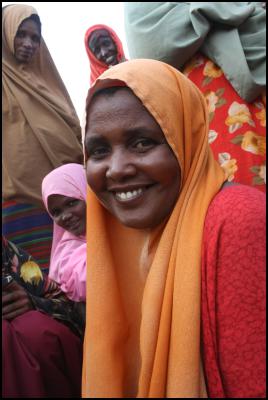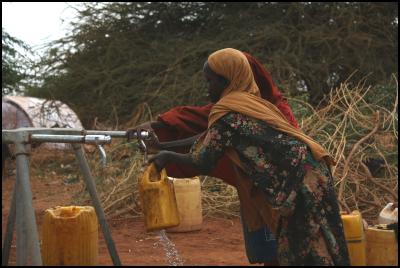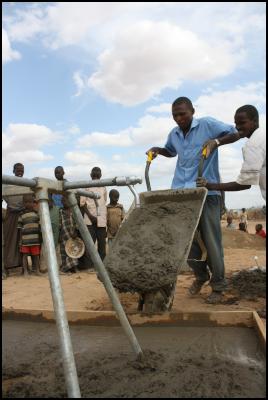Rescuing Hope and Dadaab Camp
Rescuing Hope and Dadaab Camp
Report – By Barry Coates in the Horn of Africa.
I was nervous about going to Dadaab camp. I had expected to find people who were in desperate conditions, and for it to be a harrowing experience. But instead I found wonderfully upbeat people who were grateful to be able to have food, clean water, toilets and, above all, a safe environment. Their stories were inspirational.
We left Nairobi early, on a light plane for Dadaab. When we arrived there were dark clouds around, a sign that the small rains, due at this time of the year, will hopefully come soon. We visited the new refugee camps where the populations are rising by hundreds of people each day.



The first thing that struck me about Dadaab was the scale. Today, there are about 460,000 people in the camps. This is like putting the population of greater Wellington - the capital city of my home country New Zealand - plus a few small towns onto a dry dusty plain in tents. The rain clouds drifted off and it became hot. The temperature in the tents was like an oven. Dadaab is a haven for those escaping famine and conflict, but it is still a tough environment to live in.
We were able to meet some of the people and talk to them through interpreters. The stories of how they got to the camp were really tough. One woman with a young child had walked for 30 days from central Somalia to get to Dadaab. Her husband had left her and she had lost a child on the journey. She, as others, said that the camp has saved her life. She would have died if she had stayed in her village.
A 13-year old girl, in her second year at school, was able to speak English. She had been driven from her home by fighting close to the Kenya-Somalia border. She said that her life was much better in the camp.
The majority of the new arrivals are women and children, and in the camps we visited, are all from Somalia. We met few men. Many have been killed in the fighting over decades in their country, but others have stayed to look after the few remaining livestock. I had a chance to talk to a group of young men from a south-central district where Oxfam has been supporting food and water distribution, but it was not in a village where we have yet been able to provide longer-term assistance. I asked why they left. The young man said, "We had nothing left. We couldn't grow crops for several seasons and our livestock had died. There are no jobs there. Nothing." When I asked if they would go back if the rains come, they said no. Not until the fighting stops. This was the same story from everyone. There will be no return of refugees until there is peace in Somalia.
We also heard some really heartrending stories. The two children who had been abandoned and were being taken care of by people staying nearby in the camp. Their mother had left to try to find her husband. The kids had measles, along with many other children in the camp.
But what stayed with me was the incredibly positive attitude of the people. The woman who had started a little business with her generator, charging mobile phones. The man sewing shirts with an old-fashioned treadle sewing machine. The traders who had set up in the local market. And I remembered that Somali people are some of the world's best traders. Wherever you go around the world, they are selling belts or scarves in the tourist destinations and setting up businesses. The dynamism and energy of these people was very evident.
It was the kids, however, who stole my heart. They were curious and playful and shy, crowding around us at any opportunity, with huge smiles. They are like children anywhere, enjoying the life that they can find, even in a really difficult environment.
Without exception everyone I talked to said that clean water and toilets provided by Oxfam were good. Oxfam is the lead agency on water and sanitation for all the new camps in Dadaab. The logistics of gearing up to do that within a short period of time are impressive. We saw one of the boreholes that Oxfam has been installing - pumping out 80,000 litres of clean water per day - and the system of holding tanks, header tanks and tap stands to distribute it. This provides around 25,000 people with an average of 15 litres per day, way below the usage of most New Zealanders, but enough for people who are careful in their water use.
The aid being provided by generous donations from Oxfam supporters is getting through and making a difference to people's lives. Families are being forced into the most momentous decision to leave their communities, their homes and their lives to embark on an incredibly dangerous and arduous journeys to Dadaab. The camps are a safe haven in a brutal world of famine and fighting. They provide a place for people to survive. The images of Dadaab have defined the public's perception of this crisis. As the media cycle moves on, the images of starving people entering the camps are no longer on our TV screens. But the need remains, greater than before.
The Somali people in Dadaab will not be going home soon, and the camps will need our support until the rains come and peace is established in Somalia. This is a crucial time for people to give again to help the Somali people. Providing funding when there is blanket TV coverage shows generosity. Providing funding when the images have faded from public view shows real compassion.
Oxfam New Zealand works with people around the world to end the injustice of poverty.


 Richard S. Ehrlich: The Dalai Lama's Escape & CIA Money
Richard S. Ehrlich: The Dalai Lama's Escape & CIA Money Binoy Kampmark: Addressing Hate Speech And Incitement - Holding Meta Accountable In Africa
Binoy Kampmark: Addressing Hate Speech And Incitement - Holding Meta Accountable In Africa Binoy Kampmark: Closed For Business - The Oddities Of Trump’s Tariffs
Binoy Kampmark: Closed For Business - The Oddities Of Trump’s Tariffs Martin LeFevre - Meditations: Teach Children The Distinction Between The World And Nature
Martin LeFevre - Meditations: Teach Children The Distinction Between The World And Nature Ramzy Baroud: Civil War On The Horizon? The Ashkenazi-Sephardic Conflict And Israel’s Future
Ramzy Baroud: Civil War On The Horizon? The Ashkenazi-Sephardic Conflict And Israel’s Future Gordon Campbell: On The Government’s Latest Ferries Scam
Gordon Campbell: On The Government’s Latest Ferries Scam